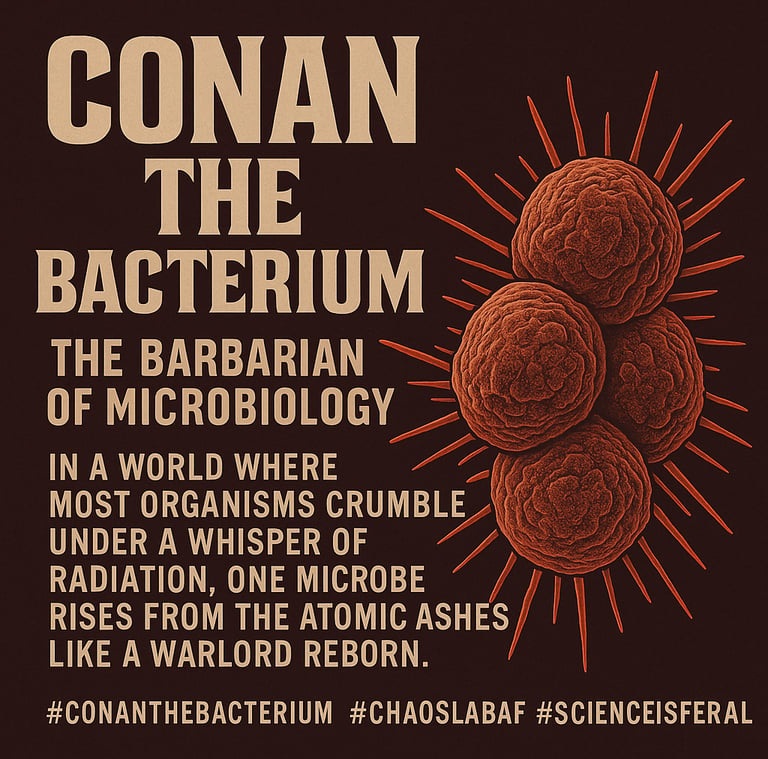Chaos by Nomenclature: Conan the Bacterium
Conan the Bacterium—Deinococcus radiodurans—doesn’t just survive radiation, he dominates it. This microbial warlord can withstand doses that would destroy most life, then calmly rebuild his genome like a molecular necromancer. Beyond being metal, Conan’s abilities have real-world potential—from space survival to biotech innovation. He’s not just tough—he’s CHAOS Lab material.
BADASS MICROBESNAMES THAT SLAPWHY DON'T WE NAME THINGS LIKE THIS ALWAYS?POP CULTURE X SCIENCECHAOS VIBESFERAL SCIENCECHAOS APPROVED TITLE
5/27/20252 min read
In a world where most organisms crumble under a whisper of radiation, one microbe rises from the atomic ashes like a warlord reborn.
Enter Conan the Bacterium.
Sure, you can call him Deinococcus radiodurans if you want to flex your Latin, but let’s not pretend that name does justice to the sheer apocalyptic swagger of this microbe. Thankfully, the scientists at Northwestern said what we’ve all been thinking: this is not your average extremophile—it’s a molecular gladiator, a DNA-repairing beast forged in the crucible of chaos.
And they’re not exaggerating.
Conan doesn’t survive radiation. He eats it for breakfast and asks for seconds.
While most life forms would dissolve into a sad little protein puddle at just a fraction of the ionizing radiation Conan endures, this microbial titan takes the hit, shrugs it off, and then proceeds to reassemble its shattered genome with the calm precision of a war medic rebuilding a battle plan from burning maps.
The new study drops a killer detail: Conan doesn’t just have resilience—it activates it. Think biological DEFCON 1. As soon as damage is detected, it initiates a coordinated, multilayered response that includes protective proteins, genomic triage teams, and metabolic lockdowns designed to buy time while the damage-control units roll in. Every part of this organism knows its role. Every gene is tuned for survival.
This isn’t defense. It’s a counterstrike.
Let’s take a moment to appreciate what this actually means.
Conan has been found surviving environments that simulate nuclear fallout, Martian UV exposure, and straight-up outer space. Space. As in, the unshielded vacuum hellscape where even cockroaches fear to tread. And Conan’s just chilling. Repairing. Rebuilding. Ready for the next round.
If that’s not metal, I don’t know what is.
But this isn’t just a fun flex for Team Microbe. The implications are huge.
We’re talking real-world, sci-fi-turned-science-now applications:
Astronaut protection: What if we could engineer protective proteins or DNA-repair systems based on Conan’s playbook to safeguard humans in deep space?
Medical preservation: Imagine vaccines, tissues, or even organs stored with microbial-inspired bio-stability—no cryo required.
Synthetic biology platforms: Radiation-resistant organisms that can clean up nuclear waste, terraform other planets, or operate in reactors without flinching.
That’s not just resilience. That’s transformation.
Here at the CHAOS Lab, we live for this kind of energy.
Because let’s be honest—survival is nice, but enduring with style? That’s the goal.
We don’t want our microbes meek. We want them screaming into the void, flipping radiation the bird, and holding their genomes together with protein stitches and sheer spite.
Conan the Bacterium is more than a scientific curiosity.
He’s a symbol—a banner-carrier for the kind of organisms that defy extinction, outlive the odds, and refuse to go quietly.
That’s the kind of attitude we salute. That’s the kind of science we chase.
So here’s to Conan:
A microbe with the resilience of a demigod, the attitude of a barbarian, and the genomic toolkit of a molecular surgeon.
May we all face our chaos with even half his rage and precision.
Raise your pipettes.
Raise your swords.
Science just got a new champion.
Read the full article from Northwestern here:
👉 How Conan the Bacterium Withstands Extreme Radiation


Built for fallout. Named for legend. Fear the microbe.
